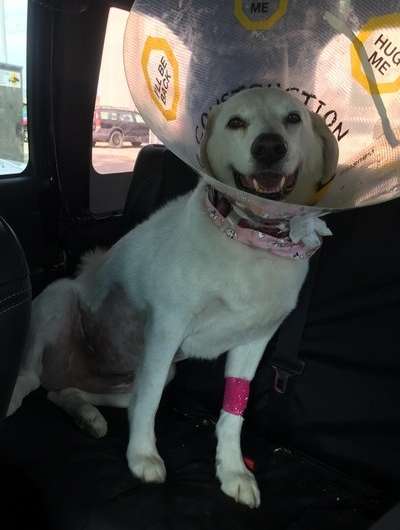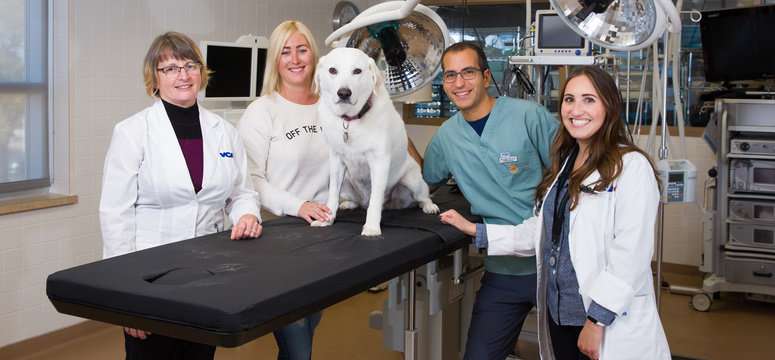New minimally invasive procedure saves dog's life—and her kidney

Lucy, a Lab-Akita cross, was a perfectly healthy, happy nine-year-old dog until the day she started peeing blood.
Lucy's owner, Mindy Ages, brought her to see the family veterinarian. After a series of tests that ruled out the usual causes of bloody urine (bladder stones or urinary tract infections), Lucy was referred Dr. Serge Chalhoub, an internal medicine specialist at the CARE Centre.
"It's scary to see your otherwise healthy dog suddenly start urinating blood in significant quantities," says Chalhoub, a senior instructor at the University of Calgary Faculty of Veterinary Medicine (UCVM), who has specialized training in canine kidney issues.
Chalhoub examined Lucy and confirmed she had a rare condition called idiopathic renal hematuria (IRH).
With IRH, a small vessel within one or both kidneys suddenly starts to bleed for no identifiable reason. The blood flows into the bladder and out in the urine. The condition is potentially life threatening as "essentially the kidney bleeds severely into the urine to the point of needing blood transfusions." Severe anemia and obstructive blood clots can develop. Traditional treatment was to remove the affected kidney.

"The problem with that treatment is that while a dog can live a normal life with one kidney, if the remaining kidney becomes sick then it's in trouble," Chalhoub explains. "And about a third of IRH cases involve both kidneys."
New procedure treats life-threatening canine condition without having to remove a kidney
Fortunately for Lucy, a minimally invasive procedure called sclerotherapy has recently been developed to treat IRH without having to remove a kidney. Using a combination of a surgical approach and fluoroscopy (live, moving X-rays) to gain access to the affected kidney, iodine and silver nitrate are instilled to chemically cauterize the bleeding vessels. After the sclerotherapy is done, a temporary stent is placed in the ureter (the duct urine passes through from the kidney to the bladder) to protect it from potential damage from leaking caustic agents postoperatively.
Lucy was the first dog in Calgary to benefit from this new procedure. And she was particularly fortunate because Dr. Lauren Adelman, a UCVM alumna with expertise in the new sclerotherapy procedure, had just returned to Calgary to provide specialized small animal internal medicine care at the Western Veterinary Specialists and Emergency Centre. Adelman gained her expertise in sclerotherapy during an internal medicine residency at the College of Veterinary Medicine at the University of Tennessee.

"IRH wasn't recognized as a syndrome until recently," says Adelman. "Now, it's becoming more well known, most often in young, large breed dogs, and so primary veterinarians are picking that up and sending them on as referrals." Lucy's sclerotherapy team included Adelman, Chalhoub and Dr. Teresa Schiller, a board-certified surgeon and associate dean, Clinical Programs at UCVM.
After the two-hour procedure, Lucy's renal bleeding stopped almost instantaneously. "It was incredible to see" says Ages, Lucy's owner. "One day her urine was full of blood, the next day it was back to being yellow. They saved our girl and from the bottom of our hearts we are eternally grateful."
Ages hopes that what she went through—the frightening onset of bloody urine in Lucy, the time and cost of tests to rule out common illnesses, the eventual diagnosis and successful treatment of her dog—will help other pets and their owners in the future.
"I feel like Lucy's case can help create awareness of this rare disease. I want people to be aware of this because I can see it could easily be misdiagnosed," says Ages. Other than the dark red blood in her urine, Lucy showed no signs that might point to other diseases—she ate well, had lots of energy and wasn't in any pain or discomfort.

'They saved my dog's life'
"She was a totally normal dog with no other symptoms before this happened. And because of this procedure, her quality of life now is exactly the same as the day before she started peeing blood.
"I'm so thankful for Dr. Chalhoub and Dr. Adelman and Dr. Schiller. And their team, all the nurses are amazing, and they treated Lucy so well," says Ages. "I'm just so relieved and so grateful. I mean they saved my dog's life. It's a happy ending."
Provided by University of Calgary




















